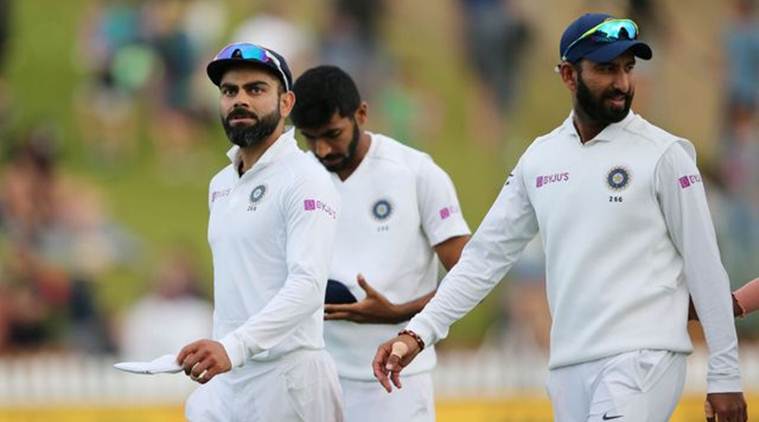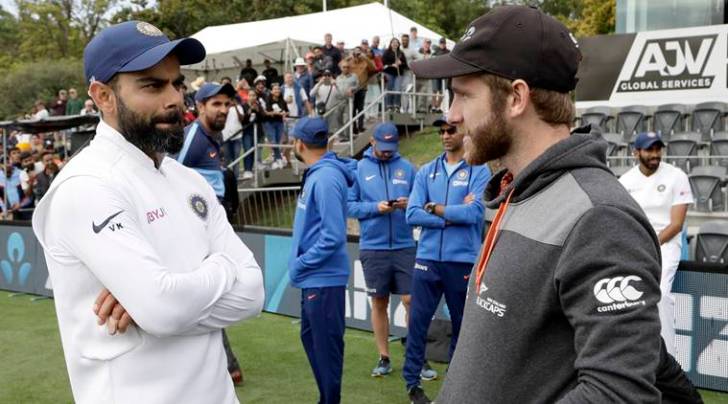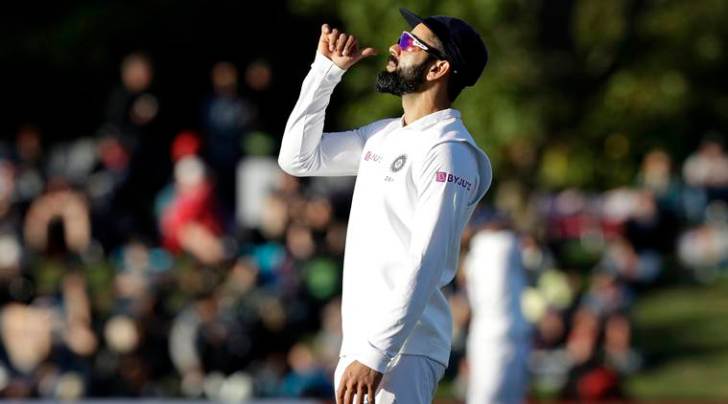 India lost 2-0 in the Test series against New Zealand. (REUTERS)
India lost 2-0 in the Test series against New Zealand. (REUTERS)
Of all Virat Kohli’s responses at the press conference after the series defeat, his reaction to a query on his on-field behaviour took centre stage. However, it was his comments about his team-mates that was more significant, as it revealed the state of affairs of his captaincy.
“I truly believe that we made too much of the conditions from the first day onwards of the first Test: overcast, a bit of dampness on the pitch. We never used to speak of these things before. So yeah, it can creep in every now and then, it’s about not letting it grow … we don’t go into conditions and think that we might not be able to execute what we want to…If you’re not clear in your head, then the feet don’t move. You’re not quite sure whether to play the shot or not, leave the ball or play the ball.”
Those comments strengthen the impression gained over time that Kohli has not just over-rated his team-mates but also deceived himself that his alpha-male-approach of ‘being brave and fearless’ is the team’s default mental state.
It’s that thought that has driven his captaincy style for a while now. It’s an appreciable quality but needs a judicious mix of attitude-shaping strategies and appreciation of reality. One without the other is counter-productive. Better captains know this reality, they strive to seal that gap by inspiring the players to extend themselves.
The great Imran Khan had the right balance. He regularly instilled fearlessness in his pack but also knew his very talented teammates all too well. His attitude-reshaping method was reflected in the story of him walking up to Aaqib Javed, sensing the young bowler was over-awed about bowling to an imperious Viv Richards, to tell him, “Maaro B******od ko ek bouncer.” In Aquib’s telling almost three decades later, “After that I began to think like a lion.”
Even if you disregard the talent pool under him, the Imran way wasn’t just restricted to that courage-through-irreverence yell of an expletive. He also hand-held all the bowlers, carefully raising their skills with his cricketing wisdom. He would also pick the brains of the team’s seniors — Javed Miandad and Mudassar Nazar — to strategise and manage other cricketing affairs.
The New Zealand tour party had many unsure cricketers. They were dealing with the demons of the mind as they faced the mercilessly disciplined bowling attack.
 Virat Kohli talks with Prithvi Shaw ahead of the second Test against New Zealand in Christchurch. (AP Photo)
Virat Kohli talks with Prithvi Shaw ahead of the second Test against New Zealand in Christchurch. (AP Photo)
Prithvi Shaw was troubled by swing and the bouncer. Mayank Agarwal was hobbled by the inswinger. Hanuma Vihari is gutsy but not without batting problems. Rishabh Pant hasn’t the defence or the confidence in his attack to handle the Kiwi pacers or the conditions. As for Ajinkya Rahane, we will come to him later.
Expecting spunkiness from this anxious bunch wasn’t just naive but insensitive too.
Another well-documented aspect of Kohli’s captaincy has been his lack of patience with players. Once again, his alpha-male approach has seen him frequently changing the Test playing XI over the last couple of years.
A team on tenter-hooks, is also team full of self-doubt. So when Kohli complains about his batsmen’s iffy demeanour at the crease — “If you’re not clear in your head, then the feet don’t move.” — it’s a problem to which he has contributed.
During the last Test series in England, in 2018, a few players had shared some concerns showing that insecurity was seeping into the camp over the chopping and changing. It makes sense to reiterate a couple of concerns from that period. “You start to second guess, kyun aisey kar rahe hain? (Why are they doing this?) You then start feeling you are on your own here,” a player had said.
Rahane in New Zealand was a perfect case study about insecure batters. Two years ago, he wasn’t just a senior batsman but it could be argued that he could challenge Cheteshwar Pujara for the best Test batsman after Kohli.
He was dropped for a few Tests, triggering the latent sense of self-doubt. He might have looked assured when he led India to a crucial Test win against Australia in 2017, but he is capable of getting clouded in doubt. This is not to say that his decline is solely the after-effect of selection issues.
He has always had an instinct to counter-attack his way out of semi-crisis on the field and it does coat itself with a dash of panic or injudicious shot-selection when he isn’t his confident self.
 Indian captain Virat Kohli, left, talks with New Zealand captain Kane Williamson. (AP Photo/Mark Baker)
Indian captain Virat Kohli, left, talks with New Zealand captain Kane Williamson. (AP Photo/Mark Baker)
Even in 2016, during a home series against England when he had problems against spinners, his attempted escape routes were strewn with such an approach. Watch his 43-ball 9 in the second Test in Christchurch — a collage of outlandish pulls, bizarre cut shots, shimmies towards off and leg side — to see Rahane’s last ditch effort that reflects the confusion in the camp.
It’s time Kohli pauses to rethink his team’s game plan. For this he needs to show empathy to players grappling with career-threatening personal crisis. He has done this before. During that Test series in England, a night before the last day of the final Test at the Oval, he had called Pant to his room. Before that knock, he had scores of 24, 1, 0, 18 and 5.
“That night, he called me to have a talk,” Pant had shared last year. “He said that it’s not compulsory that you have to play 30 matches or something to get experience. It can come in even two matches. ‘Jo koi nahin kiya, tu kar sakta hai. Kuchh likha thodi hai, if you are young, you can’t do it in Tests’. That talk helped me a lot. For him to sit me down and make me understand things, was a very big thing for me.” Pant hit a century the next day; it was admittedly a flat track but considering his prior performances in that series, it wasn’t a small thing.
So what has been going on in the Pant headspace in recent months? Sample what he said in December, months after the batting implosions at the World Cup. “There’s nothing called a natural game and we need to play as per the demands of the team. Good players are those who play as per the demands of the team and situations,” he had said.
 Virat Kohli gestures to the crowd during the second Test against New Zealand (Source: AP)
Virat Kohli gestures to the crowd during the second Test against New Zealand (Source: AP)
This sounds right but it hasn’t played out that way in the middle. Pant didn’t have the defensive game or the confidence in attack the bowlers in New Zealand. What he is saying is right, good players certainly play as per the demands of the team and situation but they are also aware about their own limitations and their current form. Pant in New Zealand seemed like a batsman caught in an indecisive mental limbo, neither attacking or defending well.
Interestingly, this team’s biggest high — first away Test win in Australia — hasn’t been driven by Kohli’s gung-ho approach. It was built around Pujara’s cautious resilience and utmost self-restraint. However, in Kohli’s world, even Pujara’s methods were appropriated to suggest the resilience was part of the team’s alpha-male philosophy. But by his own admission, Pujara had decided to shut out all external noise, chose his own way, and stuck to it.
Maybe, the biggest lesson of this tour is the team needs a flexible and sensitive leadership approach.